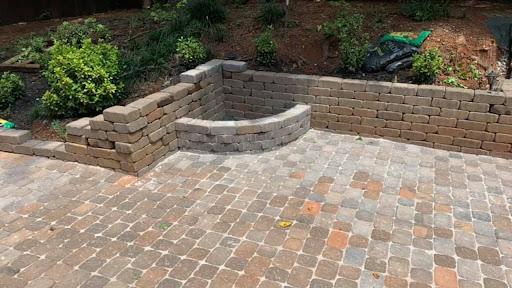Blogs

What Are The Key Considerations For Installing A Retaining Wall?
Key considerations for installing a retaining wall include understanding soil type and drainage needs, choosing durable materials, ensuring compliance with local building codes, designing for load handling, and providing a solid foundation with proper reinforcement and drainage systems.
When planning to install a retaining wall, several key considerations must be taken into account to ensure its effectiveness, stability, and compliance with local regulations. At Greystone Hardscapes, we focus on the following primary factors to ensure your retaining wall project meets all necessary standards:
Key Takeaways
Purpose and Design: Dictates wall design and materials.
Soil Analysis and Drainage: Essential for stability and preventing hydrostatic pressure.
Local Regulations and Permits: Ensures compliance and safety.
Material Selection: Influences durability, cost, and appearance.
Wall Height and Structural Integrity: Requires engineering for taller walls.
Foundation and Construction Techniques: Critical for wall stability.
Future Maintenance: Ensures longevity and prevents costly repairs.
Essential Considerations for Designing and Installing a Retaining Wall
Purpose and Design
Understanding the primary purpose of the retaining wall is crucial. Whether it's for erosion control, creating usable space, or aesthetic enhancement, this will dictate the design and materials used. For example, if the wall is primarily for preventing soil erosion, additional drainage solutions will be necessary.
Soil Analysis and Drainage
A thorough soil analysis is essential. The type of soil affects the wall's design, as different soils have varying bearing capacities. Sandy soils drain well, while clayey soils can retain moisture and exert more pressure on the wall. Proper drainage systems, such as weep holes or drainage pipes, must be incorporated to prevent water accumulation, which can lead to hydrostatic pressure and potential wall failure.
Local Regulations and Permits
Before construction, it is vital to research local building codes and regulations. Many municipalities have specific guidelines regarding wall height, materials, and construction methods. Obtaining the necessary permits ensures compliance and safety, especially for walls exceeding certain heights, which may require engineering assessments.
Material Selection
Choosing the right materials is critical for the wall's durability and appearance. Common materials include concrete blocks, natural stone, brick, and treated timber. Each material has its own advantages and disadvantages, impacting both cost and longevity. For example, natural stone offers aesthetic appeal but can be more labor-intensive and expensive compared to concrete blocks.
Wall Height and Structural Integrity
The height of the wall significantly influences its design and stability. Taller walls must be designed to withstand greater lateral pressures from both soil and water. Consulting with an engineer is advisable for walls over 1 meter (approximately 3.3 feet) to ensure they can handle the expected loads without failure.
Foundation and Construction Techniques
A solid foundation is vital for the wall's stability. The foundation should be made of compacted earth or gravel and extend beyond the wall's base width. Additionally, techniques such as incorporating geotextiles for reinforcement and ensuring the wall leans slightly back into the slope (cant or batter) can enhance stability.
Future Maintenance
Finally, consider the long-term maintenance of the retaining wall. While a well-constructed wall may require minimal upkeep, periodic inspections for signs of wear, erosion, or damage are essential to prolong its lifespan. Budgeting for future maintenance can prevent costly repairs down the line.
By carefully considering these factors, you can ensure that your retaining wall not only serves its intended purpose but also remains structurally sound and visually appealing for years to come. Greystone Hardscapes is here to help you navigate these considerations and achieve a lasting and beautiful result.
The Importance of Soil Analysis in Hardscaping
When starting any hardscaping project, conducting a thorough soil analysis is essential. This analysis helps determine the soil's bearing capacity, moisture content, and composition, which are critical for designing stable and durable structures. Different soil types affect the hardscaping in various ways: sandy soils drain efficiently but may require extra support for structures like retaining walls, while clayey soils retain moisture, increasing pressure on walls and risking potential failure. A detailed soil analysis allows for the appropriate selection of materials and construction methods, ensuring that your hardscape can withstand environmental factors and remain functional over time. At Greystone Hardscapes, we emphasize the importance of soil testing to ensure that every project is built on a solid foundation, contributing to the overall longevity and success of your outdoor space.
Key Points:
Soil Bearing Capacity: Determines structural support needs.
Moisture Content: Affects drainage and pressure on structures.
Soil Composition: Influences material choice and design.
Sandy Soils: Good drainage but may need extra support.
Clayey Soils: Can retain moisture, leading to increased pressure.
Drainage Solutions for Hardscapes
Effective drainage is a cornerstone of successful hardscaping projects. Proper drainage prevents water accumulation, which can cause issues such as hydrostatic pressure, soil erosion, and structural damage. Implementing solutions like weep holes, French drains, and appropriate grading is essential for maintaining the integrity of hardscapes. For instance, retaining walls should incorporate drainage pipes to manage water flow and reduce pressure on the structure. Addressing drainage early in the design phase helps ensure that your hardscape remains functional and aesthetically pleasing, even during heavy rainfall. Greystone Hardscapes prioritizes effective drainage solutions to enhance the durability and performance of your outdoor spaces, safeguarding them from potential water-related issues.
Key Points:
Weep Holes: Allow water to escape from walls.
French Drains: Redirect water away from structures.
Proper Grading: Ensures effective water runoff.
Drainage Pipes: Reduce pressure on retaining walls.
Early Planning: Prevents water-related issues.
Choosing the Right Materials for Hardscaping Projects
Selecting the appropriate materials for hardscaping projects is crucial for achieving durability, aesthetics, and cost-effectiveness. The choice of materials affects the overall look, longevity, and maintenance requirements of the hardscape. Common options include concrete blocks, natural stone, brick, and treated timber. Concrete blocks are versatile and budget-friendly, while natural stone provides a classic, high-end appearance but is often more labor-intensive and costly. At Greystone Hardscapes, we guide clients through the material selection process, considering factors such as climate, soil conditions, and design preferences. This careful selection ensures that your hardscape not only meets your aesthetic goals but also stands the test of time.
Key Points:
Concrete Blocks: Cost-effective and versatile.
Natural Stone: Offers timeless beauty but at a higher cost.
Brick: Classic appearance with moderate cost.
Treated Timber: Functional for certain designs.
Material Selection: Influences durability, aesthetics, and cost.
Navigating Local Building Codes for Hardscape Projects
Understanding and adhering to local building codes is vital for any hardscaping project to ensure legal compliance and safety. Building codes can dictate various aspects of hardscape design, including wall height, setback requirements, and material specifications. For retaining walls, especially those exceeding specific heights, local regulations may require engineering assessments and permits. Greystone Hardscapes is well-versed in the local building codes in the greater Charlotte, North Carolina area, ensuring that all projects meet the necessary standards and regulations. By navigating these codes effectively, we help prevent legal issues and ensure that your hardscape is both safe and compliant.
Key Points:
Wall Height Regulations: May require permits and assessments.
Setback Requirements: Ensure safety and compliance.
Material Specifications: Adhere to local standards.
Engineering Assessments: Needed for taller walls.
Compliance: Avoids legal issues and ensures safety.
Maintaining Your Hardscape: Tips for Longevity
Regular maintenance is essential to preserve the beauty and functionality of your hardscape. Over time, hardscapes may show signs of wear, erosion, or damage, making periodic inspections crucial. Maintenance tasks such as cleaning pavers, sealing surfaces, and checking for proper drainage can significantly extend the lifespan of your hardscape. At Greystone Hardscapes, we provide expert advice and services to help keep your outdoor spaces in excellent condition year-round. Implementing a maintenance routine helps prevent costly repairs and ensures that your hardscape continues to enhance your outdoor living environment.
Key Points:
Periodic Inspections: Identify signs of wear and damage.
Cleaning Pavers: Maintains appearance and functionality.
Sealing Surfaces: Protects against weathering and stains.
Checking Drainage: Prevents water damage.
Routine Maintenance: Extends lifespan and prevents costly repairs.
FAQs
What is the primary purpose of a retaining wall?
Retaining walls are primarily used for erosion control, creating level areas in sloped landscapes, and enhancing aesthetic appeal.Why is soil analysis important for retaining wall construction?
Soil analysis determines the soil's bearing capacity and moisture content, which are crucial for designing a stable and durable retaining wall.Do I need a permit to build a retaining wall?
Yes, many localities require permits, especially for walls exceeding a certain height, to ensure compliance with safety and building codes.What materials are best for retaining walls?
Common materials include concrete blocks, natural stone, brick, and treated timber. The choice depends on factors like desired aesthetics, budget, and structural requirements.How can I ensure my retaining wall lasts for many years?
Ensure proper design, use quality materials, incorporate effective drainage, and conduct regular maintenance and inspections.
Build Lasting and Beautiful Retaining Walls with Greystone Hardscapes
Retaining walls are a vital component of functional and aesthetically pleasing landscapes. From soil analysis to material selection, every step requires careful consideration to ensure stability and longevity. Greystone Hardscapes, based in the greater Charlotte,
Contact us now at Greystone Hardscapes for expert consultation and quality craftsmanship. Our dedicated team is here to turn your hardscaping dreams into reality, ensuring top-notch service and superior results. Don't wait—reach out to us now and start your journey towards a beautiful and functional outdoor space.
You Dream It.
We Build It.
Superior Craftmanship.
Every Time.
Hardscape Services:
Copyright © Greystone Hardscapes Inc. 2025. All Rights Reserved. Privacy Policy. Terms & Conditions. Web Design by Fused Media

